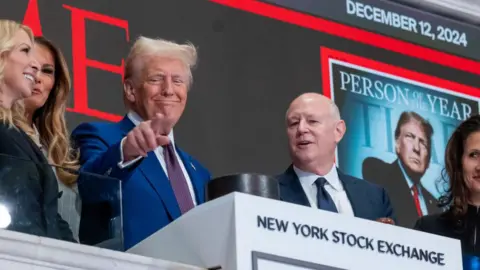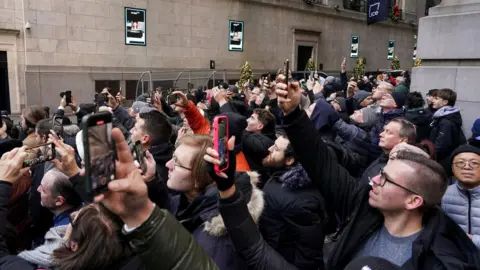
 Getty Images
Getty ImagesDonald Trump stood on Wall Street on Thursday, a euphoric crowd of America’s business elite assembled before him, and hammered the bell to kick off morning stock market trading.
The mood was celebratory. Not only had the president-elect just been named Time person of the year, but the stock market, already up strongly, has surged to new heights since his election.
For Trump, whose public appearances have been relatively sparing since his election win last month, the visit was a reminder of the high value he places on market opinion.
But whether history will look back on his appearance as the well-timed heralding of another economic boom – or a death knell – remains to be seen.
Trump is entering office with a US economy that is, in the recent words of America’s central bank boss, Jerome Powell, the envy of many other countries, with solid growth of 2.8%, unemployment near historic lows of 4.2% and that mysterious ingredient known as “productivity” on a tear.
It has combined to push American stocks to record levels: The Dow Jones Industrial Average is on track to end the year up more than 17%.
The S&P 500, a bigger index made up of America’s 500 largest companies, has surged 28% since January, while the Nasdaq, where tech firms have a major presence, has rallied more than 40%.
Investors are hoping for more, with the Trump administration expected to loosen regulations and green-light takeovers that might have come under harsh review during President Joe Biden’s administration.
At the stock exchange on Thursday, a who’s who of the business world, including Goldman Sachs boss David Solomon and Target chief Brian Solomon, had assembled. The president-elect was greeted with sustained applause and whistles, which later gave way to chants of “USA! USA!”
His visit marked a relatively rare appearance by a sitting or former president.
 Reuters
ReutersBut analysts have warned that current highs may be difficult to sustain in the year ahead.
Job creation is already slowing and price inflation is proving stubborn.
Many of Trump’s priorities – including slashing government spending, erecting stiff, broad-based trade barriers and embarking on mass deportations of migrants – if enacted, could pose further challenges to growth.
Though debate is ongoing about how much the president actually will do, the proposals are generating uncertainty and have the potential for significant disruption, said Mark Zandi, chief economist at Moody’s Analytics.
“The totality of the policies, if implemented to the degree that the president has articulated, I think will be problematic for the economy,” he said.
At the stock exchange on Thursday, Trump kept his comments focused on other parts of his agenda more palatable to markets: his promises to lower taxes from 21% to 15% for businesses manufacturing in America, cut regulation and speed up government approvals.
“A nuclear power plant – I would say a week would be enough time. What do you think?” he said, to laughter.
Similar policies, which Zandi said would be good for the corporate bottom line, if not necessarily the economy, boosted share prices significantly during Trump’s first term.
He cited those gains repeatedly as a sign of his administration’s success, especially at the start.
But the market retreated during trade wars with allies and with China – then nose-dived at the onset of the Covid-19 pandemic, before rapidly recovering.
Ultimately, the S&P 500 gained more than 67% on his watch – a record bested by presidents Bill Clinton in the 1990s and Barack Obama during his first four years.
Under Biden, the index has risen 59% so far. Whether Trump can repeat that performance is something he has declined to predict.
Asked at the stock exchange what investors should be buying in anticipation of the future, Trump, somewhat uncharacteristically, demurred.
“I don’t want to get into a situation where they do and we have a dip or something”, he said, then added, “Long term, this is going to be a country like no other.”



Be the first to comment